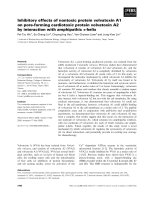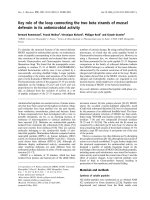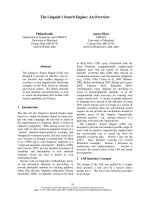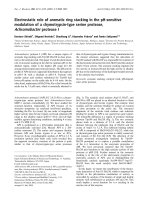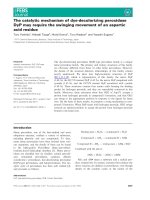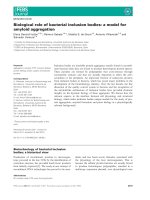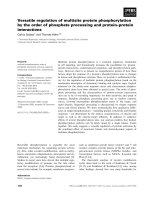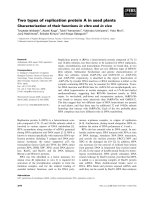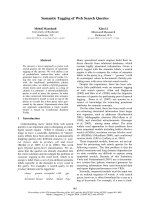Báo cáo khoa học: The role of Tyr71 in Streptomyces trypsin on the recognition mechanism of structural protein substrates ppt
Bạn đang xem bản rút gọn của tài liệu. Xem và tải ngay bản đầy đủ của tài liệu tại đây (744.15 KB, 13 trang )
The role of Tyr71 in Streptomyces trypsin on the
recognition mechanism of structural protein substrates
Yoshiko Uesugi*, Hirokazu Usuki, Masaki Iwabuchi and Tadashi Hatanaka
Research Institute for Biological Sciences, Okayama, Japan
Introduction
Serine proteases play key roles in physiological and
cellular functions, including protein processing, tissue
remodelling, immunity, cell differentiation and blood
clotting [1]. Serine proteases of clans SA (chymotryp-
sin-like) [2], SB (subtilisin-like) [3] and SC (a ⁄ b-hydro-
lase fold) [4] maintain a strictly conserved catalytic
site geometry comprising serine, histidine and aspartic
acid residues. They catalyse peptide bond hydrolysis,
which generally proceeds in a three-step mechanism:
the formation of an enzyme–substrate complex; acyla-
tion of the active site serine; and hydrolysis of the
acyl-enzyme intermediate [5].
Substrate recognition, especially the specificity at the
S1 site, has been studied extensively. The specificity at
this site in the chymotrypsin-like serine proteases has
been explained using the structure of the S1 pocket,
which comprises three b-sheets (residues 189–192,
214–216 and 224–228) and the oxyanion-binding site
Keywords
collagenolytic enzyme; repeat-length
independent and broad spectrum (RIBS)
in vivo DNA shuffling; serine protease;
Streptomyces; topological specificity
Correspondence
T. Hatanaka, Research Institute for
Biological Sciences, Okayama, 7549-1
Kibichuo-cho, Kaga-gun, Okayama 716-1241,
Japan
Fax: +81 866 56 9454
Tel: +81 866 56 9452
E-mail:
*Present address
Department of Biomaterials, Field of Tissue
Engineering, Institute for Frontier Medical
Sciences, Kyoto University, Japan
(Received 7 April 2009, revised 26 July
2009, accepted 4 August 2009)
doi:10.1111/j.1742-4658.2009.07256.x
Studies of substrate recognition by serine proteases have focused on speci-
ficities at the primary S1–Sn sites, but topological specificities (i.e. recogni-
tion at distinct three-dimensional structural motifs) have not been
established. This is the first report to identify the key amino acid residue
conferring topological specificity. A serine protease from Streptomyces omi-
yaensis (SOT), which is a trypsin-like enzyme, was chosen as a model
enzyme to clarify the recognition mechanism of structural protein sub-
strates in serine proteases. We have found previously that the topological
specificities of SOT and S. griseus trypsin (SGT) for high molecular mass
substrates differ greatly, even though the enzymes have similar primary
structures. In this study, we constructed chimeras between SOT and SGT
using an in vivo DNA shuffling system and several mutants to identify the
key residues involved in topological specificities. By comparing the sub-
strate specificities of chimeras and mutants, we found that residue 71 of
SOT, which is separate from the catalytic triad, contributes to the topologi-
cal specificity. Using site-directed mutagenesis, residue 71 of SOT was also
found to be crucial for catalytic efficiency and enzyme conformation.
Abbreviations
ADAMTS, a disintegrin and metalloproteinase with thrombospondin motifs; ANS, 1-anilinonaphthalene-8-sulfonic acid; CBD, collagen-binding
domain; FITC, fluorescein isothiocyanate; LB, Luria–Bertani; MMP, mammalian matrix metalloprotease; RIBS, repeat-length independent
and broad spectrum; SGT, Streptomyces griseus trypsin; SOT, Streptomyces omiyaensis serine protease; Z-Gly-Pro-Arg-MCA,
benzyloxycarbonylglycyl-
L-prolyl-L-arginine-4-methylcoumaryl-7-amide.
5634 FEBS Journal 276 (2009) 5634–5646 ª 2009 The Authors Journal compilation ª 2009 FEBS
(Gly193 and Ser195) in the C-terminal b-barrel
domain. Specificity is usually determined by the resi-
dues at positions 189, 216 and 226 [6,7]. For example,
the combination of Ser189, Gly216 and Gly226 creates
a deep hydrophobic pocket in the chymotrypsin
enzyme that accounts for S1 specificity. Furthermore,
Asp189, Gly216 and Gly226 create a negatively
charged S1 site that confers specificity of trypsin for
substrates containing arginine or lysine at the P1 posi-
tion [8,9]. Surface loops 1, 2 and 3 (residues 184–195,
213–228 and 169–175, respectively) are also important
for substrate specificity. The specificities of S2–Sn sites
have also been investigated using elastase [10]. How-
ever, the mechanism by which serine proteases recog-
nize the structure of protein substrates is not known.
Various structural features govern interactions between
protease and substrate, and therefore insight into the
mechanism is necessary to explain substrate recogni-
tion. Data on the topological specificities are available
only for the metalloproteinase ADAMTS (a disintegrin
and metalloproteinase with thrombospondin motifs)
and the mammalian matrix metalloproteases (MMP),
which were obtained using triple-helical and single-
stranded fluorogenic substrates [11].
Recently, serine protease-catalysed degradation of
recalcitrant animal proteins, such as collagen [12,13],
keratin [14], those involved in blood clotting [15,16]
and amyloid prion proteins [17], has been of interest
because of potential industrial waste and medical
applications. We therefore selected collagens as ‘hard-
to-degrade’ substrates for our study of how serine pro-
teases recognize protein substrate structure. At least 25
different types of collagen have been identified [18].
For example, collagen types I, II, III, V and IX are
classical fibrillar collagens, whereas collagen type IV
forms sheet-like networks [19]. Collagen degradation
products have biological activities of industrial and
medical interest. In addition, from the screening of
2000 soil isolates, we obtained a serine protease from
Streptomyces omiyaensis (SOT) with high collagenolyt-
ic activity [12]. SOT belongs to the trypsin family and
the peptidase family S1 (subfamily S1A). The primary
structure of SOT is 77% identical to that of the trypsin
from Streptomyces griseus (SGT, EC 3.4.21.4) [20–22],
but the topological specificity of the former differs sub-
stantially from that of the latter. Therefore, we used
SOT as a model for enzymes that hydrolyse hard-
to-degrade proteins in order to clarify how serine
proteases recognize structural protein substrates.
For the identification of the amino acid residues
conferring topological specificity of our model serine
protease, we first constructed chimeras of SOT with
SGT using repeat-length independent and broad spec-
trum (RIBS) in vivo DNA shuffling [23], and com-
pared their substrate specificities. Using type I and
type IV collagens as typical protein substrates with
different structures, we identified a key residue on the
substrate recognition site that conferred specificity for
the substrates.
Results and Discussion
Construction of chimeras using RIBS in vivo DNA
shuffling
In a previous study, we demonstrated that SOT had
wide substrate specificity for types I and IV collagens,
gelatin and casein, whereas SGT only showed high
substrate specificity towards type I collagen [12]. To
investigate which domain confers the different topolog-
ical specificities, we constructed a chimeric gene library
between SOT and SGT using RIBS in vivo DNA shuf-
fling (Fig. 1A). This system is a method of random
chimeragenesis based on the combination of highly fre-
quent deletion formation in the Escherichia coli ssb-3
strain with an rpsL-based chimera selection system.
We have demonstrated previously the substrate recog-
nition mechanism in Streptomyces phospholipase D
using this system [23–25].
We obtained various chimeras with recombination
sites widely distributed over the entire chimeric gene.
The DNA sequences of the parental sot gene and the
trypsin gene (sprT) encoding SGT (in S. griseus NBRC
13350) [21] are 82% identical. Therefore, these genes
are suitable for chimeragenesis using the RIBS in vivo
DNA shuffling system. We chose eight typical chime-
ras, as presented in Fig. 1B, for gene expression and
protein purification. The purified chimeras appeared as
a single band on SDS-PAGE, and the molecular mass
(approximately 23 kDa) was similar to that of SOT
and SGT (data not shown).
Comparison of substrate specificities for
chimeras towards protein substrates
The substrate specificities of eight chimeras were evalu-
ated using fluorogenic bovine skin collagen type I and
human placenta collagen type IV as substrates, and
these were compared with those of parental SOT and
SGT (Fig. 2). In a previous study, we showed that the
hydrolytic activities of SOT and SGT towards fluores-
cein-labelled collagens agreed well with those towards
native collagens [12]. Figure 2A, B shows that the spe-
cific activities of chimeras A and B towards type I and
IV collagens resemble those of SGT. Chimeras A and
B show much lower activities towards type IV collagen
Y. Uesugi et al. Substrate recognition mechanism of Streptomyces trypsin
FEBS Journal 276 (2009) 5634–5646 ª 2009 The Authors Journal compilation ª 2009 FEBS 5635
than do other chimeras or SOT. Interestingly, the
hydrolytic activity of chimera F towards both types of
collagen was the highest among the chimeras and
higher than that of parental SOT and SGT. These spe-
cific activities were used to calculate the ratio of the
hydrolytic activity towards type IV collagen relative to
that towards type I collagen (collagen IV⁄ I) (Fig. 2C).
The ratios of chimeras C–H were comparable with that
of SOT. They were, however, significantly different
from those of chimeras A, B and SGT. These results
suggest that the region between chimeras B and C
(corresponding to residues 52–72 of SOT) confers sub-
strate specificity. Therefore, we examined this region
further.
Identification of amino acid residue(s) related to
topological specificity
Chimera B differed from chimera C in five amino acid
residues (Fig. 3A). Therefore, we constructed four
chimera B mutants (B-1 to B-4, the primary sequence of
which is presented in Fig. 3A) and evaluated their speci-
ficities towards two collagen types. For type I collagen,
the specific activity of the chimera B mutant increased
as substituted residues accumulated (Fig. 3B). In con-
trast, the specific activity of the chimera B mutant
towards type IV collagen changed considerably between
B-3 and B-4 (Fig. 3C). These results were reflected in
collagen IV ⁄ I (Fig. 3D). Figure 3A shows that chimeras
A
P
T7
-lac
pACTI2b
(sot/Gm
r
rpsL
+
/sprT)
lacl
q
Cm
r
E. coli MK1019 ssb-3
Transformation
RpsL(Sm
r
)
RpsL(Sm
s
)
RpsL(Sm
r
)
sot
sprT
Gm
r
rpsL
+
P
T7
-lac
P
T7
-lac
Cm
r
Cm
r
Gm
r
lacl
q
lacl
q
sot
sprT
rpsL+
SGT
223 aa
in vivo DNA shuffling
Chimeric genes
SOT
Chimera A
Chimera B
Chimera C
Chimera D
Chimera E
Chimera F
Chimera G
Chimera H
223 aa
223 aa
0 50 100 150
200
B
AB
CD
E
111213141
51 61 71 81 91
E
FG
H
101 111 121 131 141
151 161 170 180 190
200 220210
Fig. 1. Random chimeragenesis between
sot and sprT genes by RIBS in vivo DNA
shuffling. The random chimeragenesis strat-
egy (A) is detailed in ref. 23. For construc-
tion of the shuffling vector, two
homologous genes (sot and sprT) were
placed in the same direction, and a cassette
containing the Gm
r
and E. coli rpsL
+
genes
was inserted between them. rpsL
+
encodes
the ribosomal protein S12 [23], the target of
Sm. The transformation of E. coli MK1019
[ssb-3 rpsL(Sm
r
)] with pACTI2b (sot ⁄ Gm
r
-
rpsL
+
⁄ sprT) altered the phenotype of cells
from Sm
r
to Sm
s
(and also Gm
s
to Gm
r
)
because the Sm
s
ribosome was reconsti-
tuted with the wild-type RpsL protein
encoded by the plasmid. The Gm
r
-rpsL
+
cassette is simultaneously deleted from the
plasmid and the cells reverse their pheno-
type from Sm
s
⁄ Gm
r
to Sm
r
⁄ Gm
s
when
recombination occurs between two homolo-
gous genes. Consequently, the intact form
of the chimeric gene is selectable by Sm
and Cm without expression. The primary
structures of SGT, SOT and the eight chime-
ras used in this study are illustrated sche-
matically. The recombination sites of
chimeras A–H are shown in (B). The primary
structures of SOT (upper) and SGT (lower)
are shown. The recombination sites of the
chimeras are boxed. The names of the chi-
meras are indicated in bold capital letters.
The catalytic residues are indicated in red.
Substrate recognition mechanism of Streptomyces trypsin Y. Uesugi et al.
5636 FEBS Journal 276 (2009) 5634–5646 ª 2009 The Authors Journal compilation ª 2009 FEBS
B-3 and B-4 differed in only one amino acid residue: res-
idue 71. From these results, we inferred that Tyr71 of
SOT (corresponding to residue 89 of a-chymotrypsin
numbering) is a key amino acid residue conferring sub-
strate specificity. To visualize the location of Tyr71 in
SOT, an overall structure of SOT was constructed based
on the crystal structure of SGT [22]. Interestingly, the
residue is located in the b-sheet separate from the cata-
lytic triad of His37, Asp82 and Ser172 (corresponding
to residues 57, 102 and 195 of a-chymotrypsin number-
ing; Fig. 3E).
Effect of mutations on substrate specificity
Next, we tried to prepare 11 SGT mutants and an
SOT mutant, in which residue 71 was substituted for
other amino acids, to investigate the role of Tyr71 of
SOT in topological specificity. We obtained mutants as
active forms, except for an SGT mutant with proline
substituted for Leu71 (SGT-L71P). Figure S1 shows
SDS-PAGE data from several culture supernatants of
SGT mutants. Unlike other mutants, the band at the
molecular mass of SGT-L71P was hardly observed,
but many other bands were seen. In addition, the cul-
ture supernatant had no activity. In the case of inac-
tive SOT and SGT, in which Ser172 of the catalytic
triad was substituted with alanine, many high molecu-
lar mass bands were observed (data not shown),
although these bands were not observed in active
forms. It is probable that correctly folded mutants
could hydrolyse these high molecular mass proteins.
For SGT-L71P, low molecular mass bands were also
observed at positions different from the case of active
mutants. We speculate that SGT-L71P, which was not
folded correctly, was presumably hydrolyzed by other
proteases in the culture. These results suggest that
residue 71 also affects the folding of SGT.
Five purified SGT mutants (substitution of Leu71
with tyrosine, phenylalanine, tryptophan, alanine or
histidine) showed higher activity towards type IV colla-
gen than did wild-type SGT (Fig. 4B, left). In parti-
cular, the collagen IV ⁄ I values of SGT-L71Y and
SGT-L71H were twice as high as that of SGT
(Fig. 4C, left). Furthermore, mutant SOT-Y71L
showed significantly lower specific activity towards
type IV collagen than did wild-type SOT, although
SOT-Y71L showed high activity towards type I colla-
gen, similar to SOT (Fig. 4A, B, right). From these
results, it is interesting to note that the substitution
with hydrophobic or bulky amino acids in wild-type
SGT imparts a significant change in specific activity
towards type IV collagen.
We further evaluated the effect of mutations on
the specificities for native type I collagen substrates
from bovine Achilles’ tendon and type IV collagen
from human placenta (Fig. 5). The activities of SGT-
L71Y (which showed the greatest change in substrate
150
200
250
Collagen type I
A
0
50
100
SGT A
B C
D
E F G H SOT
Specific activity (U·mg
–1
)
SGT A
B C
D
E F G H SOT
Specific activity (U·mg
–1
)
B
40
60
80
100
120
Collagen type IV
0
20
SGT A
B C
D
E F G H SOT
Collagen IV/I
0.4
0.5
0.6
Type IV/I
C
0
0.1
0.2
0.3
Fig. 2. Comparison of the specific activities for chimeras A–H,
parental SGT and SOT towards different fluorescein-conjugated
substrates. The reactions were performed using bovine skin DQ-
collagen type I (A) and human placenta DQ-collagen type IV (B) in
50 m
M Tris ⁄ HCl (pH 8.0) containing 10 mM CaCl
2
at 37 °C. Enzyme
activity was measured by monitoring the fluorescence (FITC)
release (excitation, 395 nm; emission, 415 nm). The data are
expressed as the means ± SD of three independent experiments.
(C) Ratio of the hydrolytic activity towards type IV collagen to that
towards type I collagen.
Y. Uesugi et al. Substrate recognition mechanism of Streptomyces trypsin
FEBS Journal 276 (2009) 5634–5646 ª 2009 The Authors Journal compilation ª 2009 FEBS 5637
specificity among the SGT mutants), SOT-Y71L,
wild-type SOT and SGT were compared. The colla-
genolytic activity of SGT-L71Y for type IV collagen
was 3.3-fold higher than that of SGT (Fig. 5B),
although the activity of SGT-L71Y towards type I
collagen was somewhat lower than that of SGT
(Fig. 5A). In contrast, SOT-Y71L and SOT hydroly-
zed type I collagen similarly, but the activity of the
former towards type IV collagen was 2.2-fold lower
than that of the latter. As shown in Fig. 5C, collagen
IV ⁄ I of SGT-L71Y was 4.8-fold higher than that of
SGT, whereas it was lower for SOT-Y71L than SOT.
These results showed good agreement with those
obtained using fluorescein-labelled collagens. There-
fore, we conclude that Tyr71 of SOT confers topo-
logical specificity.
The ability of the mutation to hydrolyze the collagen
mimic substrate was determined using benzyloxycarbon-
ylglycyl-l-prolyl-l-arginine-4-methylcoumaryl-7-amide
(Z-Gly-Pro-Arg-MCA), which is frequently employed
as a substrate in studies of the collagenolytic cysteine
proteinase, cathepsin K [26,27]. The specific activity was
1.4-fold higher in SGT-L71Y (90.3 lmolÆmin
)1
Æmg
)1
)
than SGT (66.1 lmolÆmin
)1
Æmg
)1
), and 2.6-fold lower
in SOT-Y71L (190.2 lmolÆmin
)1
Æmg
)1
) than SOT
(501.5 lmolÆmin
)1
Æmg
)1
). For this short peptide sub-
strate, substitution of residue 71 has little effect, unlike
the response seen with the structural protein substrates.
The k
cat
value of SGT-L71Y (51.3 s
)1
) was 1.6-fold
higher than that of SGT (33.0 s
)1
), although their K
m
values were equivalent (Table 1). Conversely, both K
m
and k
cat
values of SOT-Y71L were approximately
three-fold higher than those of SOT, resulting in a dra-
matic decrease in the catalytic efficiency (k
cat
⁄ K
m
value) of SOT-Y71L. The value was lower than that of
SOT by one order of magnitude. These results suggest
D82
Y71
S172
H37
A
B
C
B
52
G GVVDLQSSSAV KVRSTKVLQ
72
B-1 A GVVDLQSSSAV KVRSTKVLQ
B-2 A GVVDLQSSSA I KVRSTKVLQ
Amino acid sequence
B-3 A GVVDLQSSSA I KVRSTK ILQ
B-4 A GVVDLQSSSA I KVRSTK IYQ
C A GVVDLQSSSA I KVRSTK IYR
D
E
Collagen IV/I
0.2
0.3
0.4
Type IV/I
0
0.1
B B-1 B-2 B-3 B-4 C
120
140
Collagen type I
0
20
40
60
80
100
Specific activity (U·mg
–1
)
B B-1 B-2 B-3 B-4 C
50
60
Collagen type IV
Specific activity (U·mg
–1
)
0
10
20
30
40
B B-1 B-2 B-3 B-4 C
Fig. 3. Identification of an amino acid
residue related to topological specificity.
Primary structures of chimera B and C
mutants (A) and their specific activities
towards DQ-collagen type I (B) and DQ-col-
lagen type IV (C). These activities were
measured in 50 m
M Tris ⁄ HCl (pH 8.0) con-
taining 10 m
M CaCl
2
at 37 °C. The data are
expressed as the mean ± SD of three inde-
pendent experiments. (D) The ratio of the
hydrolytic activity towards type IV collagen
to that towards type I collagen. (E) The key
residue (Tyr71 of SOT) for the overall
structure of SOT is represented using the
Swiss-pdb viewer based on the SGT crystal
structure. Tyr71 is indicated in pink with the
residues in an active site.
Substrate recognition mechanism of Streptomyces trypsin Y. Uesugi et al.
5638 FEBS Journal 276 (2009) 5634–5646 ª 2009 The Authors Journal compilation ª 2009 FEBS
that residue 71 affects both topological specificity and
catalytic efficiency significantly.
Conformational change of SOT and SGT induced
by the substitution of residue 71
We measured the CD and fluorescence spectra of
SGT-L71Y, SOT-Y71L, SOT and SGT to investigate
the effect of the mutation at residue 71 on the tertiary
and secondary structures of SOT and SGT. Figure 6A
shows that the CD spectra of SOT-Y71L and SGT-
L71Y were drastically different from those of wild-type
SOT and SGT. The spectra of the tryptophan fluores-
cence emissions of the wild-type and mutants were also
dramatically different (Fig. 6B, C). SOT and SGT
have five and four tryptophan residues, respectively,
that contributed to their fluorescence emission spectra.
Figure 6B, C shows that the emission maximum,
A
B
60
80
100
120
100
150
200
Collagen type I
SGT-L71X
0
20
40
SGT Y F W A G R H D N S
Specific activity (U·mg
–1
)
Specific activity (U·mg
–1
)
0
50
SOT-
Y71L
SOT
C
SGT-L71X
SGT Y F W A G R H D N S
Specific activity (U·mg
–1
)
Specific activity (U·mg
–1
)
30
100
Collagen type IV
10
20
20
40
60
80
0
0
SOT-
Y71L
SOT
SGT-L71X
SGT Y F W A G R H D N S
Collagen IV/I
Collagen IV/I
0.2
0.3
0.4
0.3
0.5
0.6
Type IV/I
0
0.1
0
0.1
0.2
SOT-
Y71L
SOT
Fig. 4. Effects of mutations on topological
specificity. Specific activities of SGT-L71X
mutants (left) and SOT-Y71L (right) towards
DQ-collagen type I (A) and DQ-collagen type
IV (B) were measured in 50 m
M Tris ⁄ HCl
(pH 8.0) containing 10 m
M CaCl
2
at 37 °C.
The data are expressed as the mean ± SD
of three independent experiments. (C) The
ratio of hydrolytic activity towards type IV
collagen to that towards type I collagen.
Y. Uesugi et al. Substrate recognition mechanism of Streptomyces trypsin
FEBS Journal 276 (2009) 5634–5646 ª 2009 The Authors Journal compilation ª 2009 FEBS 5639
around 330 nm, was the same for all enzymes.
SOT-Y71L showed an extremely low fluorescence
emission intensity compared with that of wild-type
SOT. In contrast, SGT-L71Y showed a higher fluores-
cence emission intensity than did wild-type SGT.
Moreover, the CD and fluorescence spectra of SGT-
L71F resembled those of SGT-L71Y, and the fluores-
cence spectrum of SGT-L71S resembled that of SGT
(data not shown). The measurements were performed
under the same pH conditions for the above assays
(pH 8; optimum pH of SOT and SGT). Of course, the
autolysates of the mutants were not observed on SDS-
PAGE. Furthermore, we confirmed that these confor-
mational changes were not caused by the disruption of
the enzyme form using the hydrophobic fluorescence
probe 1-anilinonaphthalene-8-sulfonic acid (ANS)
(Fig. S2). The fluorescence of ANS increases substan-
tially when the hydrophobic core regions of proteins,
which are inaccessible to the dye in the native struc-
ture, are exposed. The respective fluorescence intensi-
ties of ANS with SOT, SGT and their mutants were
similar to those without the enzymes, suggesting that
the substitution of residue 71 induced conformational
changes in the secondary and tertiary structures of
wild-type SOT and SGT without disruption of the
enzyme form. From these results, we consider that the
conformational changes induced by the substitution of
residue 71 affect the topological specificity.
New insights into substrate recognition
The reaction mechanism within the catalytic triad and
the specificities of the S1–Sn sites of chymotrypsin-like
serine protease have been studied extensively [5–9].
However, the recognition mechanism for structural
protein substrates remains unclear. Studies of cathepsin
K showed that its unique collagenolytic activity among
cathepsins is caused by a preference for arginine and
lysine at the P1 position and proline and glycine at the
P2 and P3 positions [28]; neither of these residues, espe-
cially proline, is preferred by other human cathepsins.
Previously, we have studied the residue preferences in
SOT and SGT using fluorescence energy transfer
A
Collagen type I
3000
4000
5000
0
1000
2000
SGT SGT-L71Y SOT-Y71L SOT
Specifc activity (U·mg
–1
)
B
Collagen type IV
30 000
SGT SGT-L71Y SOT-Y71L SOT
Specifc activity (U·mg
–1
)
5000
10 000
15 000
20 000
25 000
0
SGT SGT-L71Y SOT-Y71L SOT
Collagen IV/I
C
Type IV/I
4
5
6
7
0
1
2
3
Fig. 5. Hydrolytic activities of SOT, SGT and their mutants towards
native collagens. Collagenolytic activity was determined by the fol-
lowing method. After preincubation of 2 mg of insoluble type I colla-
gen from bovine Achilles’ tendon (A) or type IV collagen from human
placenta (B) in 50 m
M Tris ⁄ HCl (pH 8.0) containing 10 mM CaCl
2
,
enzyme was added and incubated at 37 °C for 30–60 min. Next, the
reaction was terminated by the addition of 1 lL of 0.2
M HCl; the
rate of increase in free amino groups was measured using the ninhy-
drin method. Clostridium histolyticum collagenase type I was also
estimated as a reference enzyme. One collagen digestion unit liber-
ates peptides from collagen by collagenase type I equivalent in nin-
hydrin colour to 1.0 l mol of leucine in 5 h at pH 7.4 at 37 °C in the
presence of CaCl
2
. Data are expressed as the mean ± SD of three
independent experiments. (C) The ratio of hydrolytic activity towards
type IV collagen to that towards type I collagen.
Table 1. Kinetic parameters for the hydrolysis of a short peptide
substrate by SOT, SGT and their mutants.
K
m
(lM) k
cat
(s
)1
) k
cat
⁄ K
m
(lM
)1
Æs
)1
)
SGT 17.7 ± 0.6 33.0 ± 4.1 1.9
SGT-L71Y 17.2 ± 5.7 51.3 ± 7.8 3.2
SOT-Y71L 17.5 ± 2.9 93.0 ± 17.1 5.4
SOT 6.1 ± 1.9 279.5 ± 12.1 49.7
The assay was carried out using 0.03–0.5 m
M Z-Gly-Pro-Arg-MCA
in 50 m
M Tris ⁄ HCl (pH 8.0) containing 10 mM CaCl
2
at 37 °C. The
data are expressed as the mean ± SD of three independent experi-
ments.
Substrate recognition mechanism of Streptomyces trypsin Y. Uesugi et al.
5640 FEBS Journal 276 (2009) 5634–5646 ª 2009 The Authors Journal compilation ª 2009 FEBS
substrate (FRETS) combinatorial libraries [29–31],
which consist of a total of 475 peptide substrates. In
contrast with other studies, we found that the P1, P2
and P3 preferences of SOT resembled those of SGT.
However, they showed significantly different specifici-
ties towards structural protein substrates [12]. There-
fore, the other regions, distinct S1, S2 and S3 sites, are
presumed to confer topological specificity. Our previous
study showed that the N-terminal region of SOT
included a key residue that conferred topological speci-
ficity [12]. We now expand these findings using RIBS
in vivo DNA shuffling to show that Tyr71 of SOT (cor-
responding to residue 89 of a-chymotrypsin numbering)
contributes to the topological specificity. This finding
has not been inferred from structural information.
The crystal structure of SGT consists of 15 b-sheets
and two a-helices [22] (Fig. 7A). SGT is divisible into
two domains formed by six antiparallel b-sheets with a
similar topology. The catalytic triad lies in the cleft
between the two domains. Figure 7A shows that resi-
due 71 in the b-sheet of the N-terminal b-barrel
domain is located adjacent to Trp83, approximately at
3A
˚
(corresponding to residue 103 of a-chymotrypsin
numbering). Therefore, we speculate that the substitu-
tion of residue 71 affects the interaction between this
residue and Trp83, and subsequently causes a change
in the local environment around catalytic Asp82. This
hypothesis is supported by the dramatic change in cat-
alytic efficiency of SOT and SGT when carrying a
mutation at residue 71 (Table 1).
Compared with other serine proteases for the struc-
ture, the positional relationship between residue 71
and the catalytic triad in SOT almost resembles that in
bovine trypsin (PDB ID: 1k1n) [32] and a-chymotryp-
sin (PDB ID: 5cha) [33]. Ile89 and Phe89 in bovine
trypsin and a-chymotrypsin, respectively, correspond
to Tyr71 of SOT. Residue 89 in these enzymes is situ-
ated a short distance from Ile103, approximately 5 A
˚
(corresponding to Trp83 of SOT). Thus, we speculate
that these residues are not able to interact with each
other. The topological specificities of these serine pro-
teases are assumed to be changed by the substitution
of residue 89 with other amino acids in order to allow
for an interaction with Ile103.
Figure 6 shows that the conformations of SOT and
SGT differ, although the enzymes show similar hydro-
lytic activity towards type I collagen. The contribution
of an induced-fit mechanism to the substrate specificity
of aminoacyl-tRNA synthetase and adenylate kinase
has been reported recently [34,35]. Moreover, the 60-
loop of thrombin lining the upper rim of the active site
entrance is rearranged by binding exosite I of throm-
bin and the protease-activated receptor PAR3 [36].
A
0
0.5
[θ] × 10
–6
(deg·cm
2
·d
–1
)
Wavelength (nm)
200 220 240 260
–1
–0.5
SOT
SOT-Y71L
SGT
SGT-L71Y
C
300
400
500
SGT
SGT-L71Y
300 320 340 360 380
0
100
200
Wavelen
g
th (nm)
Fluorescence intensity (arbitrary units)
B
500
SOT
100
200
300
400
SOT-Y71L
300 320 340 360 380
0
Wavelength (nm)
Fluorescence intensity (arbitrary units)
Fig. 6. Conformation of SOT, SGT and their mutants. CD spectra
(A) and tryptophan fluorescence emission spectra (B, C) of SOT,
SGT and their mutants were measured at room temperature in
10 m
M Tris ⁄ HCl (pH 8.0) containing 10 mM CaCl
2
, as described in
Materials and methods.
Y. Uesugi et al. Substrate recognition mechanism of Streptomyces trypsin
FEBS Journal 276 (2009) 5634–5646 ª 2009 The Authors Journal compilation ª 2009 FEBS 5641
Indeed, the 60-loop shifts 3.8 A
˚
upwards and causes a
180° flip of W60d that projects the indole ring into the
solvent and opens up the active site fully, when PAR3
binds to exosite I, although the indole ring of W60d
partially occludes access to the active site and restricts
the specificity towards physiological substrates and
inhibitors in free thrombin. Based on these findings,
we propose that residue 71 triggers induced fitting
when the enzyme–substrate complex is formed in the
first step of the reaction mechanism. Consequently, the
environment around the active site presumably changes
to allow structural protein substrate attachment; it
engenders change in topological specificity.
Finally, this is the first report to identify the key
amino acid residue conferring topological specificity in
Streptomyces trypsin. The general collagenases, such
as MMP and Clostridium histolyticum collagenase,
have a collagen-binding domain (CBD) [37,38], and
Tyr994 in this domain is the critical residue for inter-
action with collagen [38]. The hydroxyl group of this
residue probably forms hydrogen bonds with main-
chain atoms to form a protein–collagen complex.
Because the molecular size and structure of trypsin-
like serine proteases and these collagenases differ, the
domain corresponding to the CBD remains elusive.
Nevertheless, residue 71 might also contribute to colla-
gen-binding. Figure 7B shows that the residue is
located in the basic surface charged region. Thus, SOT
and SGT might possess other collagen-binding regions
that act synergistically with residue 71 to promote the
binding of the acidic surface of collagens to the basic
surface charged region of the enzyme. Studies are
underway using surface plasmon resonance analysis to
determine the role of residue 71 in collagen binding.
The elucidation of the mechanism of structural protein
substrate recognition in serine proteases should help
advance therapeutic research into the prevention and
treatment of thrombotic and neurodegenerative dis-
eases caused by ‘hard-to-degrade’ proteins.
Materials and methods
Materials
A spin column (Vivapure S; Vinascience, Sartorius AG,
Aubagne, France) and DQ-collagens (Molecular Probes
Inc., Eugene, OR, USA) were used for this study. Type I
collagen from bovine Achilles’ tendon, type IV collagen
from human placenta and Clostridium histolyticum collage-
nase type I were purchased from Sigma-Aldrich Inc.
(St Louis, MO, USA). Z-Gly-Pro-Arg-MCA was obtained
from Peptide Institute Inc. (Minoh, Osaka, Japan). All other
unspecified chemicals were of the highest purity available.
Construction of plasmid for RIBS in vivo DNA
shuffling
The plasmid for RIBS in vivo DNA shuffling was con-
structed as described previously [23]. A plasmid containing
the sot and sprT genes cloned in tandem was constructed as
follows. The sot gene in plasmid pUC18 was digested with
NdeI and KpnI. The sprT gene in pCR-Blunt II-TOPO was
digested with KpnI and HindIII. Next, the sot and sprT
genes were ligated into the NdeI–HindIII gap of plasmid
pACTI2b [23], yielding pACTI2b(sot ⁄ sprT). The Gm
r
-
rpsL
+
cassette from pNC124 [23] was digested with KpnI,
and the cassette was inserted into the KpnI site between the
sot and sprT genes in pACTI2b(sot ⁄ sprT) to construct
pACTI2b(sot ⁄ Gm
r
-rpsL
+
⁄ sprT) (Fig. 1A). The resulting
vector was used for RIBS in vivo DNA shuffling.
Random chimeragenesis
Figure 1 shows the random chimeragenesis strategy. First,
E. coli MK1019 [ssb-3 rpsL(Sm
r
)] was transformed with
S172
D166
37H
D82
Y71
B
S172
D166
W83
37H
D82
Y71
A
Fig. 7. The amino acid residues related to
topological specificity and the conformation
of the three-dimensional structures. (A) The
overall structure of SOT is portrayed using
the Swiss-pdb viewer based on the crystal
structure of SGT. The key residue is indi-
cated in red (Tyr71 of SOT). The residues in
the catalytic site are also shown. (B) The
surface charge is represented using the
Swiss-pdb viewer. Acidic and basic surface
charges of SOT are shown as red and blue,
respectively.
Substrate recognition mechanism of Streptomyces trypsin Y. Uesugi et al.
5642 FEBS Journal 276 (2009) 5634–5646 ª 2009 The Authors Journal compilation ª 2009 FEBS
pACTI2b(sot ⁄ Gm
r
-rpsL
+
⁄ sprT) by electroporation. The
transformants were selected using Luria–Bertani (LB) plates
containing chloramphenicol and gentamicin. The Cm
r
⁄ Gm
r
transformant sensitivities to streptomycin (Sm
s
) were con-
firmed on LB plates containing chloramphenicol, gentami-
cin and streptomycin. The Sm
s
transformants from each
host were cultivated in LB medium containing chloramphe-
nicol. Cultures were spread on LB plates containing chl-
oramphenicol and streptomycin. Plasmids isolated from 48
selected Sm
r
revertants from each host were analysed using
agarose gel electrophoresis. The 0.8 kb DNA fragment con-
taining the target gene on isolated plasmids was amplified
by PCR using LA taq with a GC buffer system (TaKaRa
Holdings, Inc.), with primers incorporating the NdeI site of
sot (5¢-CATATGCAGAAGAACCGACTCGTCC-3¢) and
the HindIII site of sprT (5¢-TGCCGGTACGAAGCTTCA
GAGCGTGCG-3¢). Recombination sites were determined
in detail using DNA sequencing.
Construction of expression vectors
To prepare chimeras, we applied a novel expression system
[39] using the expression vector (pTONA5a), which
included a promoter from Streptomyces metalloendopepti-
dase, with Streptomyces lividans 1326 as a host strain. The
chimeric gene was digested using NdeI and HindIII and
ligated into the NdeI–HindIII gap of pTONA5a to obtain
the expression vector.
Construction of expression vectors of chimera B
and C mutants
To identify the amino acid residues related to topological
specificity, we constructed chimera B and C mutants using
PCR amplification. To prepare the mutants (B-2 and B-3),
the following two mutagenic sense primers were synthesized
[the XhoI site (in italic type) was substituted with a silent
mutation]: 5¢-TCCAGTC(G fi C)TC(C fi G)AGCGCC
(G fi A, Val fi Ile)TCAAG-3¢ (corresponding to nucleotides
281–303 from sprT) and 5¢-TC(G fi C)TC(C fi G)AGC
GCC(G fi A, Val fi Ile)TCAAGGTCCGCTCCACCAAG
(G fi A, Val fi Ile)TC-3¢ (corresponding to nucleotides
286–321 from sprT). The target mutation was introduced
with primer sets of 5¢-TGCCGGTACGAAGCTTCA
GAGCGTGCG-3¢ (a reverse primer, corresponding to the
HindIII site of sprT) and each of the mutagenic primers,
using KOD-Plus (version 2, Toyobo Co. Ltd.). The partial
sot gene was amplified using PCR with a combination of a
forward primer (5¢-CATATGCAGAAGAACCGACTCG
TCC-3¢, corresponding to the NdeI site of sot) and a reverse
primer [5¢-GATGGCGCT(GCT fi CGA)GGACTGGAG
GT-3¢ for silent mutation of the XhoI site (in italic type)
and corresponding to nucleotides 284–306 from sot]. The
amplified DNA fragments were cloned into pCR-Blunt
II-TOPO (Invitrogen Corp.); the resulting plasmids were
confirmed by DNA sequencing. The plasmids representing
B-2 and B-3 were digested with XhoI and HindIII. The
plasmid representing the partial sot gene was digested with
NdeI and XhoI. The fragments were ligated into the
NdeI–Hin
dIII gap of pTONA5a to construct the expression
vector.
The following mutagenic antisense primer, in which the
KpnI site (in italic type) was substituted with a silent muta-
tion, was synthesized to prepare the mutant B-4: 5¢-CGG
T(G fi A)CCGTTGTAGCCGGGGGCCTGG(AG fi TA,
Leu fi Tyr)-3¢ (corresponding to nucleotides 322–349 from
sprT). The target mutation was introduced with primer sets
of 5¢-CATATGCAGAAGAACCGACTCGTCC-3¢ (a for-
ward primer, corresponding to the NdeI site of sot) and the
mutagenic primer described above, using KOD-Plus. The
partial sprT gene was amplified by PCR with a combina-
tion of a forward primer [5¢-CCGGCTACAAC GG(C fi
T)ACCGGCAA-3¢ for silent mutation of the KpnI site (in
italic type), corresponding to nucleotides 332–353 from
sprT] and a reverse primer (5¢-TGCCGGTACGAAGCTT
CAGAGCGTGCG-3¢, corresponding to the HindIII site of
sprT). The amplified DNA fragments were cloned
into pCR-Blunt II-TOPO, and the resulting plasmids
were confirmed by DNA sequencing. The plasmid repre-
senting B-4 was digested with NdeI and KpnI. The
plasmid representing the partial sprT gene was digested
with KpnI and HindIII. The fragments were ligated into
the NdeI–HindIII gap of pTONA5a to construct the
expression vector. To prepare the mutant B-1, the chime-
ric gene obtained by RIBS in vivo DNA shuffling was
digested using NdeI and HindIII, and ligated into the
NdeI–HindIII gap of pTONA5a to construct the expression
vector.
Construction of SGT-L71X mutants and SOT-
Y71L
We constructed SGT-L71X mutants and SOT-Y71L to
investigate the effect of distinct residues on the recognition
of the substrates. To prepare SGT-L71X mutants, the
mutagenic gene was amplified using PCR with a combina-
tion of a forward primer (5¢-CAACATATGAAGCACT
TCCTGCGTGC-3¢, corresponding to the NdeI site of sprT)
and a reverse primer [5¢-CGGT(G fi A)CCGTTGTAGC
CGGGGGCCTG(GAG fi XXX)GACCTTG-3¢ for silent
mutation of the KpnI site (in italic type), corresponding to
nucleotides 315–349 from sprT]. When XXX was GTA,
GAA, CCA, GGC, GCC, GCG, GTG, GTC, GTT, GGA
and GGG, leucine was substituted with tyrosine, phenylala-
nine, tryptophan, alanine, glycine, arginine, histidine, aspar-
tic acid, asparagine, serine and proline, respectively. The
amplified DNA fragments were then cloned, sequenced and
digested with NdeI and KpnI. The plasmid representing the
partial sprT gene with the KpnI site described above was
digested with KpnI and HindIII. The fragments were ligated
Y. Uesugi et al. Substrate recognition mechanism of Streptomyces trypsin
FEBS Journal 276 (2009) 5634–5646 ª 2009 The Authors Journal compilation ª 2009 FEBS 5643
into the NdeI–HindIII gap of pTONA5a to construct the
expression vector.
To prepare the mutant SOT-Y71L, the mutagenic gene
was amplified using PCR with a combination of a forward
primer (5¢-CATATGCAGAAGAACCGACTCGTCC-3¢,
corresponding to the NdeI site of sot) and a reverse primer
[5¢-GGGGC(T fi C)CGG(TA fi AG,Tyr fi Leu)GATCT
TGGTGGAGCGGAC-3¢ for silent mutation of the ApaI
site (in italic type), corresponding to nucleotides 310–338
from sot]. The partial sot gene was amplified using PCR
with a combination of a forward primer [5¢-GATCTA
CCG(A fi G)GCCCCCGGCTACAACGGCA-3¢ for silent
mutation of the ApaI site (in italic type), corresponding
to nucleotides 324–352 from sot] and a reverse primer
(5¢-AAGCTTTACAGCGTGGCCGCGGCGG-3¢, corre-
sponding to the HindIII site of sot). The amplified DNA
fragment was then cloned and sequenced. The plasmid rep-
resenting SOT-Y71L was digested with NdeI and ApaI. The
plasmid representing the partial sot gene was digested with
ApaI and HindIII. The fragments were ligated into the
NdeI–HindIII gap of pTONA5a to construct the expression
vector.
Expression and purification of the enzymes
SOT, SGT, their chimeras and mutants were expressed
using the expression vector (pTONA5a) with S. lividans
1326 as the host strain, and then purified using a Vivapure
S spin column as described previously [12]. Chimeras and
mutants were purified in a procedure similar to that used
for SOT and SGT. The resulting enzyme solutions were
dialysed against 10 mm Tris ⁄ HCl (pH 8.0), and the purities
of the proteins were confirmed using SDS-PAGE [40]. The
enzyme concentrations were measured using a protein assay
kit (BioRad Laboratories Inc.), which is based on the
Bradford method, according to the standard procedure.
Active site titration
To confirm the active site concentrations of SOT and SGT,
we performed titration using methylumbelliferyl p-guani-
dinobenzoate. The procedure followed that of Coleman
et al. [41], except for the use of 0.1 m sodium phosphate
buffer (pH 6.8) containing 1 mm HCl. The fluorescence
intensity was monitored at k
ex
= 323 nm and
k
em
= 446 nm using a CORONA grating microplate reader
SH-8000Lab. The active site concentrations were estimated
using a standard curve for the fluorescence of 4-methylum-
belliferone. The concentrations of SOT and SGT were 40.2
and 10.6 lm; their concentrations determined by the Brad-
ford assay were estimated at 56.8 and 15.1 lm, respectively.
The active forms of SOT and SGT accounted for 70.8%
and 70.4% of total protein, respectively. From these results,
we judged that the amounts of enzymes used in the study
were correctly matched.
Assay for enzyme activity
To estimate the substrate specificity of the enzymes, the
hydrolytic activities were determined using fluorogenic
bovine skin DQ-collagen type I and human placenta
DQ-collagen type IV, as described previously [12]. The
reaction velocity was estimated from the standard curve
plotted with data obtained using fluorescein isothiocyanate
(FITC). One unit of activity was defined as the amount of
the enzyme necessary to release 1 nmol of FITC per minute
under these assay conditions.
The collagenolytic activities of the enzymes were deter-
mined by the ninhydrin method using native insoluble type
I collagen from bovine Achilles’ tendon and type IV colla-
gen from human placenta, as described previously [12].
For the estimation of hydrolytic activity towards a short
peptide substrate, Z-Gly-Pro-Arg-MCA was used as it is a
collagen mimic substrate. The assay was performed as fol-
lows: 20 lL of the enzyme solution was added to 180 lLof
0.2 m m Z-Gly-Pro-Arg-MCA in 50 mm Tris⁄ HCl (pH 8.0)
containing 10 mm CaCl
2
in a microtitre plate well for fluo-
rescence and incubated at 37 °C. After preincubation at
37 °C for 5 min, the reaction was started by addition of the
enzyme solution; it was subsequently monitored to assess
the increase in fluorescence intensity at k
ex
= 390 nm
and k
em
= 460 nm using a grating microplate reader
(SH-8000Lab; CORONA Electric Co., Ltd). The reaction
velocity was estimated from the standard curve plotted
using 7-amino-4-methylcoumarin. In the kinetic assays, the
reactions were carried out in a mixture consisting of Z-Gly-
Pro-Arg-MCA at a final concentration of 0.03–0.5 mm in
50 mm Tris ⁄ HCl (pH 8.0) containing 10 mm CaCl
2
and the
purified enzymes under the assay conditions described
above.
CD spectroscopy
The secondary structures of the proteins were estimated by
CD spectroscopy (J-720WI; Jasco Inc.). Proteins were dis-
solved to a final concentration of 0.1 mgÆmL
)1
in 10 mm
Tris ⁄ HCl (pH 8.0) containing 10 mm CaCl
2
. Spectra were
acquired at room temperature using a cuvette (path length,
2 mm). The spectra of the proteins, an average of 10 scans,
were corrected by subtracting the spectra of the corre-
sponding background media without protein.
Fluorescence spectroscopy
Fluorescence spectra were obtained using a spectrofluorom-
eter (F-4500; Hitachi Ltd.). All measurements were carried
out at room temperature with 0.61 lm proteins in 10 mm
Tris ⁄ HCl (pH 8.0) containing 10 mm CaCl
2
using a quartz
cuvette (path length, 2 mm). The excitation wavelength was
280 nm, and the excitation and emission slits were 5 nm.
Substrate recognition mechanism of Streptomyces trypsin Y. Uesugi et al.
5644 FEBS Journal 276 (2009) 5634–5646 ª 2009 The Authors Journal compilation ª 2009 FEBS
The emission was scanned from 290 to 400 nm. The spectra
of the proteins, an average of four scans, were corrected by
subtracting the spectra of the corresponding background
media without protein.
Acknowledgements
This research was supported financially by a Grant-in-
Aid for Scientific Research (21750183).
References
1 Krem MM & Cera ED (2001) Molecular marker of
serine protease evolution. EMBO J 20, 3036–3045.
2 Lesk AM & Fordham WD (1996) Conservation and
variability in the structures of serine proteinases of the
chymotrypsin family. J Mol Biol 258, 501–537.
3 Siezen RJ & Leunissen JA (1997) Subtilases: the super-
family of subtilisin-like serine proteases. Protein Sci 6,
501–523.
4 Ollis DL, Cheah E, Cygler M, Dijkstra B, Frolow F,
Franken SM, Harel M, Remington SJ, Silman I, Schrag
J et al. (1992) The alpha ⁄ beta hydrolase fold. Protein
Eng 5, 197–211.
5 Hedstrom L (2002) Serine protease mechanism and
specificity. Chem Rev 102, 4501–4523.
6 Perona JJ & Craik CS (1995) Structural basis of sub-
strate specificity in the serine proteases. Protein Sci 4,
337–360.
7 Czapinska H & Otlewski J (1999) Structural and
energetic determinants of the S1-site specificity in serine
proteases. Eur J Biochem 260, 571–595.
8 Huber R, Kukla D, Bode W, Schwager P, Bartels K,
Deisenhofer J & Steigemann W (1974) Structure of the
complex formed by bovine trypsin and bovine pancre-
atic trypsin inhibitor. II. Crystallographic refinement at
1.9 A
˚
resolution. J Mol Biol 89, 73–101.
9 Krieger M, Kay LM & Stroud RM (1974) Structure
and specific binding of trypsin: comparison of inhibited
derivatives and a model for substrate binding. J Mol
Biol 83, 209–230.
10 Bode W, Meyer E Jr & Powers JC (1989) Human
leukocyte and porcine pancreatic elastase: X-ray crystal
structures, mechanism, substrate specificity, and
mechanism-based inhibitors. Biochemistry 28, 1951–
1963.
11 Lauer-Fields JL, Minond D, Sritharan T, Kashiwagi
M, Nagase H & Fields GB (2007) Substrate conforma-
tion modulates aggrecanase (ADAMTS-4) affinity and
sequence specificity. Suggestion of a common topologi-
cal specificity for functionally diverse proteases. J Biol
Chem 282, 142–150.
12 Uesugi Y, Arima J, Usuki H, Iwabuchi M & Hatanaka
T (2008) Two bacterial collagenolytic serine proteases
have different topological specificities. Biochim Biophys
Acta 1784, 716–726.
13 Itoi Y, Horinaka M, Tsujimoto Y, Matsui H & Watan-
abe K (2006) Characteristic features in the structure
and collagen-binding ability of a thermophilic collagen-
olytic protease from the thermophile Geobacillus
collagenovorans MO-1. J Bacteriol 188, 6572–6579.
14 Bressollier P, Letourneau F, Urdaci M & Verneuil B
(1999) Purification and characterization of a keratino-
lytic serine proteinase from Streptomyces albidoflavus.
Appl Environ Microbiol 65, 2570–2576.
15 Sugimoto S, Fujii T, Morimiya T, Johdo O & Nakam-
ura T (2007) The fibrinolytic activity of a novel protease
derived from a tempeh producing fungus, Fusarium sp.
BLB. Biosci Biotechnol Biochem 71, 2184–2189.
16 He J, Chen S & Gu J (2007) Identification and charac-
terization of Harobin, a novel fibrino(geno)lytic serine
protease from a sea snake (Lapemis hardwickii). FEBS
Lett 581, 2965–2973.
17 Hui Z, Doi H, Kanouchi H, Matsuura Y, Mohri S,
Nonomura Y & Oka T (2004) Alkaline serine protease
produced by Streptomyces sp. degrades PrP(Sc).
Biochem Biophys Res Commun 321, 45–50.
18 Kielty CM & Grant ME (2002) Molecular, genetic, and
medical aspects. In Connective Tissue and its Heritable
Disorders (Royce PM & Steinmann B eds), pp. 159–221.
Wiley-Liss, Inc., New York.
19 van der Rest M & Garrone R (1991) Collagen family of
proteins. FASEB J 5, 2814–2823.
20 Olafson RW, Jua
´
s
ˇ
ek L, Carpenter MR & Smillie LB
(1975) Amino acid sequence of Streptomyces griseus
trypsin. Cyanogen bromide fragments and complete
sequence. Biochemistry 14, 1168–1177.
21 Kim JC, Cha SH, Jeong ST, Oh SK & Byun SM (1991)
Molecular cloning and nucleotide sequence of Strepto-
myces griseus trypsin gene. Biochem Biophys Res
Commun 181, 707–713.
22 Read RJ & James MN (1988) Refined crystal structure
of Streptomyces griseus trypsin at 1.7 A
˚
resolution.
J Mol Biol 200, 523–551.
23 Mori K, Mukaihara T, Uesugi Y, Iwabuchi M & Hata-
naka T (2005) Repeat-length-independent broad-spectrum
shuffling, a novel method of generating a random chimera
library in vivo. Appl Environ Microbiol 71, 754–760.
24 Uesugi Y, Mori K, Arima J, Iwabuchi M & Hatanaka
T (2005) Recognition of phospholipids in Streptomyces
phospholipase D. J Biol Chem 280, 26143–26151.
25 Uesugi Y, Arima J, Iwabuchi M & Hatanaka T (2007)
C-terminal loop of Streptomyces phospholipase D has
multiple functional roles. Protein Sci 16, 197–207.
26 Lecaille F, Chowdhury S, Purisima E, Bro
¨
mme D &
Lalmanach G (2007) The S2 subsites of cathepsins K
and L and their contribution to collagen degradation.
Protein Sci 16, 662–670.
Y. Uesugi et al. Substrate recognition mechanism of Streptomyces trypsin
FEBS Journal 276 (2009) 5634–5646 ª 2009 The Authors Journal compilation ª 2009 FEBS 5645
27 Lecaille F, Choe Y, Brandt W, Li Z, Craik CS &
Bro
¨
mme D (2002) Selective inhibition of the collagen-
olytic activity of human cathepsin K by altering its
S2 subsite specificity. Biochemistry 41, 8447–
8454.
28 Choe Y, Leonetti F, Greenbaum DC, Lecaille F, Bogyo
M, Bromme D, Ellman JA & Craik CS (2006) Substrate
profiling of cysteine proteases using a combinatorial
peptide library identifies functionally unique specifici-
ties. J Biol Chem 281, 12824–12832.
29 Hatanaka T, Arima J, Uesugi Y & Iwabuchi M (2005)
Purification, characterization cloning, and sequencing of
metalloendopeptidase from Streptomyces septatus TH-2.
Arch Biochem Biophys 434, 289–298.
30 Tanskul S, Oda K, Oyama H, Noparatnaraporn N,
Tsunemi M & Takada K (2003) Substrate specificity of
alkaline serine proteinase isolated from photosynthetic
bacterium, Rubrivivax gelatinosus KDDS1. Biochem
Biophys Res Commun 309, 547–551.
31 Oda K, Takahashi T, Takada K, Tsunemi M, Ng KK,
Hiraga K & Harada S (2005) Exploring the subsite-
structure of vimelysin and thermolysin using FRETS-
libraries. FEBS Lett 579, 5013–5018.
32 Dullweber F, Stubbs MT, Musil D, Stu
¨
rzebecher J &
Klebe G (2001) Factorising ligand affinity: a combined
thermodynamic and crystallographic study of trypsin
and thrombin inhibition. J Mol Biol 313, 593–614.
33 Blevins RA & Tulinsky A (1985) The refinement and
the structure of the dimer of alpha-chymotrypsin at
1.67-A
˚
resolution. J Biol Chem 260, 4264–4275.
34 Xiao H, Murakami H, Suga H & Ferre
´
-D’Amare
´
AR
(2008) Structural basis of specific tRNA aminoacylation
by a small in vitro selected ribozyme. Nature 454,
358–361.
35 Whitford PC, Gosavi S & Onuchic JN (2008) Confor-
mational transitions in adenylate kinase. Allosteric
communication reduces misligation. J Biol Chem 283,
2042–2048.
36 Di Cera E (2008) Thrombin. Mol Aspects Med 29, 203–
254.
37 Xu X, Chen Z, Wang Y, Bonewald L & Steffensen B
(2007) Inhibition of MMP-2 gelatinolysis by targeting
exodomain–substrate interactions. Biochem J 406 , 147–
155.
38 Wilson JJ, Matsushita O, Okabe A & Sakon J (2003) A
bacterial collagen-binding domain with novel calcium-
binding motif controls domain orientation. EMBO J
22, 1743–1752.
39 Hatanaka T, Onaka H, Arima J, Uraji M, Uesugi Y,
Usuki H, Nishimoto Y & Iwabuchi M (2008) pTONA5:
a hyperexpression vector in streptomycetes. Protein
Expr Purif 62, 244–248.
40 Laemmli UK (1970) Cleavage of structural proteins
during assembly of the head of bacteriophage T4.
Nature 227, 680–685.
41 Coleman PL, Latham HG & Shaw EN (1976) Some
sensitive methods for the assay of trypsin like enzymes.
Methods Enzymol 45, 12–26.
Supporting information
The following supplementary material is available:
Fig. S1. SDS-PAGE of culture supernatants of SGT
and SGT-L71X mutants.
Fig. S2. ANS fluorescence emission spectra of SOT,
SGT and their mutants.
This supplementary material can be found in the
online article.
Please note: As a service to our authors and readers,
this journal provides supporting information supplied
by the authors. Such materials are peer-reviewed and
may be re-organized for online delivery, but are not
copy-edited or typeset. Technical support issues arising
from supporting information (other than missing files)
should be addressed to the authors.
Substrate recognition mechanism of Streptomyces trypsin Y. Uesugi et al.
5646 FEBS Journal 276 (2009) 5634–5646 ª 2009 The Authors Journal compilation ª 2009 FEBS

